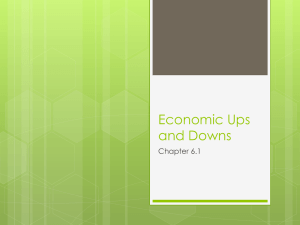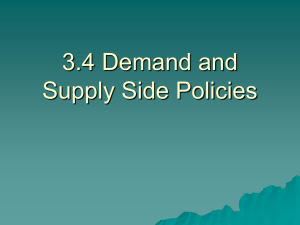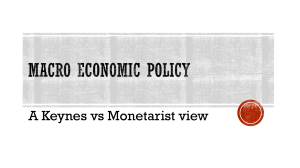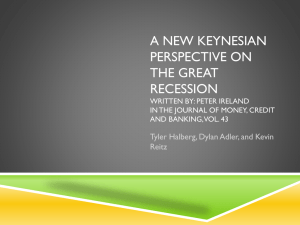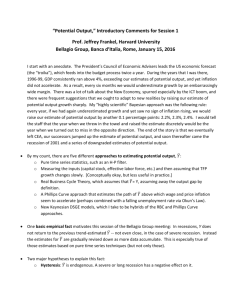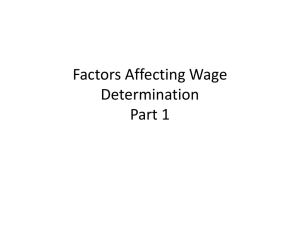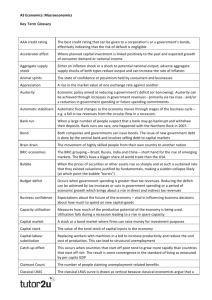Unit-1-A5
advertisement
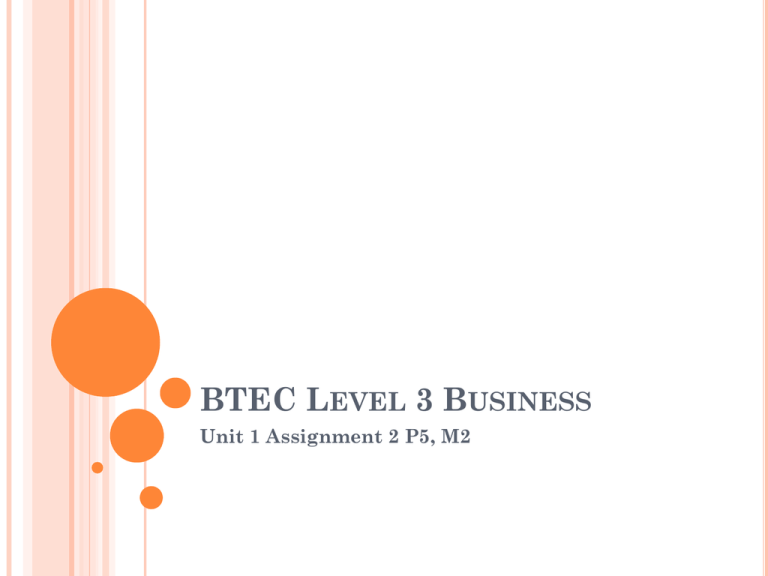
BTEC LEVEL 3 BUSINESS Unit 1 Assignment 2 P5, M2 WHAT IS THE ECONOMY? The economy is the thrifty management of resources, including money, human resources and land. As part of the economics, we will investigate; Supply and Demand Inflation GDP Economic Growth Recession SUPPLY AND DEMAND There is supply and demand for every tangible and non-tangible good. Supply is how much of the product is available Demand is how much want or need there is for a product or service Supply and demand are affected by a range of factors including; recession, growth and change in natural resources. THE ECONOMIC ENVIRONMENT The economic environment will effect a business in ways that it can not control. The economic environment is made up of individuals who buy and sell good and borrow and lend money. For a business the biggest influencers are consumers and suppliers. GROWTH In a period of growth; Incomes rise More goods are produced More goods are being purchased In a period of growth people have more money which impacts on how much they buy, this allows businesses to grow as they are selling more and allows them to employ more people- this in turn reduces unemployment and people have more disposable income. RECESSION This is the opposite to growth. People become cautious about spending and save instead Businesses sell less and therefore make less money Business make people redundant P5- THE BUSINESS ENVIRONMENT For this assignment you will need to investigate two businesses in different countries. Choose your two businesses and explain the current economic climate in both countries. Explain the affect the growth will have on both businesses Explain the affects that a recession will have on both businesses INFLATION This is the general rise in prices. Inflation can affect businesses because costs of supplies rise, businesses may pass the cost onto their customers by increasing the price they charge or see profit fall. Explain how the businesses could respond to inflation in the two contrasting countries LABOUR For most businesses wages and labour makes up 70% of costs. This means when there are any changes in labour or the external environment labour will be largely affected. Labour is essential to businesses as they must ensure they recruit the right people at the right time. In times of growth it is more difficult to recruit people with the right skills, this has caused businesses in the UK to look abroad for the right employees In times of recession it is easier to recruit because unemployment is high and there are lots of people looking for jobs CHANGES IN GOVERNMENT POLICY The government has a huge effect on businesses. A good government should ensure; There is growth and stability Inflation is low Low interest rates on loans Suitable supplies of labour The government uses taxes and spending to control the economy. Monetary Policy is about the government controlling interest rates- the government can use this to change the amount of money available. Fiscal Policy this is about the government controlling taxes, during a recession a government can reduce taxes to encourage spending and to improve the profit of businesses P5 PLAN Introduction: what is economics? Economic: importance of stability; impact on business of changes in the economic environment (growth, recession, ripple effect); levels of inflation; availability and cost of credit; labour; changes in government policy (legal, fiscal, monetary) Demand: influenced by affordability; competition; availability of substitutes; level of Gross Domestic Product (GDP); needs and aspirations of consumers Supply: Influenced by availability of raw materials and labour; logistics; ability to produce profitably; competition for raw materials; government support Changes in supply and demand: supply and demand curves; elasticity of demand; price sensitivity; influence of branding on price sensitivity Global interaction: levels and types of interdependence (supply chains, ownership of businesses, movement of capital and business operations, reducing ability of national governments to regulate global businesses) Conclusion M2 COMPARISON OF THE TWO BUSINESSES compare the challenges to selected business activities within a selected organisation, in two different economic environments Consider Economic: importance of stability; impact on business of changes in the economic environment (growth, recession, ripple effect); levels of inflation; availability and cost of credit; labour; changes in government policy (legal, fiscal, monetary)
